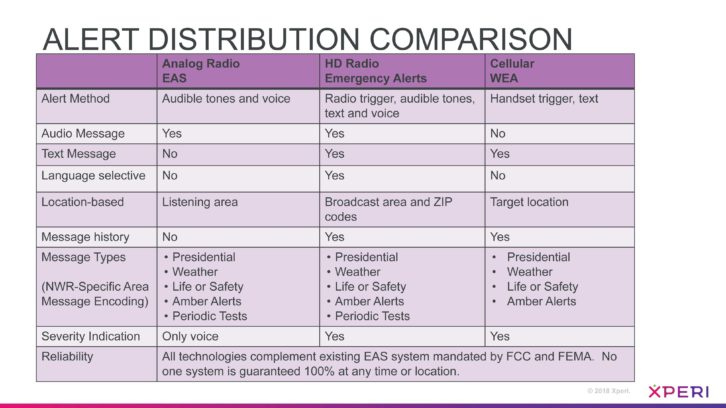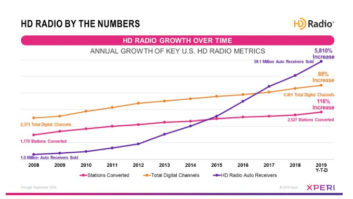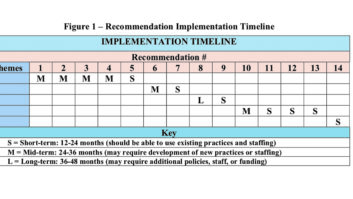The developer of HD Radio believes its technology can “upgrade and enhance the nation’s emergency alerting capabilities,” delivering alerts with better geographic targeting and dynamic visual images along with other enhancements.
So in March, a top radio technology executive of Xperi Corp. met with representatives from the FCC’s Public Safety and Homeland Security Bureau in Washington to highlight HD Radio’s emergency alert feature. According to a public filing, Xperi described improved text notifications, multilingual audio and geographically targeted messaging abilities.
The company proposed no major changes to the Emergency Alert System but sought to offer a reminder of benefits it believes HD Radio can bring to the EAS infrastructure, primarily text and future capabilities, such as images and maps.
Xperi also released a white paper, “Upgrading the Emergency Alert System: HD Radio Digital Emergency Alerting,” and shared it in the FCC meeting. The paper lists the current and planned emergency alerting capabilities like wake-up signaling and delivery of visuals.

“UNIQUELY POSITIONED”
Xperi cited a recent report from the FCC’s Communications Security, Reliability and Interoperability Council that recommended upgrading several aspects of the public alerting ecosystem. These include improving geographic targeting, enhancing public alerting systems with multimedia, improving resiliency and redundancy and improving accessibility of alert info.
“While each method of public alerting has particular strengths, HD Radio technology is uniquely positioned to enhance the overall system and fulfill many of the important recommendations made by CSRIC in its December 2018 Final Report,” Xperi wrote in its meeting summary.
The digital data capabilities of HD Radio enable digital broadcasters to “enhance their emergency messaging broadcasts by providing more rich and detailed content, including, for example, alternate languages, message text, pictures and maps,” Xperi wrote.
“Notably, the HD Radio emergency alerting broadcast protocol is completely CAP-compliant, thus allowing dissemination of all the rich content facilitated by CAP,” it stated, referring to Common Alerting Protocol.
The FCC already mandates that EAS participants be able to receive CAP-formatted alert messages. The Federal Emergency Management Administration is responsible for EAS implementation and testing.
FEMA released its own report earlier this year that touched on various themes to improve public warning via the Integrated Public Alert and Warning System, or IPAWS. FEMA recognizes the need to “optimize technical developments and how the nation’s alert and warning systems can take advantage of new capabilities,” according to the report.
At the NAB Show, FEMA featured a demonstration of HD Radio’s emergency alerting functionality at the IPAWS booth. In addition, HD Radio’s emergency alert capabilities are now integrated into FEMA’s IPAWS test bed in the IPAWS Lab in Washington, which is used to provide training and coordination planning with emergency managers, a company official confirmed.
“PART OF THE CONVERSATION”
Xperi says there are 2,141 digital on-air broadcasts in the United States, with 90% of the population living within reception distance of an HD Radio station. About 43 million HD Radio-equipped cars are on the road, according to the company.
It says approximately 300 radio stations in 85 markets are transmitting emergency alerts over HD Radio as simple text messages and that about 15% are using some of the other enhancements, said Ashruf El-Dinary, vice president of radio technology solutions, who led the Xperi visit to the FCC along with members of its legal team.
El-Dinary met with Public Safety and Homeland Security Bureau staff and detailed the potential benefits of using the in-band, on-channel digital transmission system. “It was an introductory meeting, really. To the extent that the FCC has been working on HD Radio, we wanted to make sure other bureaus within the commission were aware of the technology and how it can be applied to public alerting,” he said.
“We see it as a very strong application that will advance emergency notification across the country. HD Radio with the enhancements can support these objectives.”
El-Dinary said HD Radio alerting technology “allows for an HD Radio to scan the background looking these alerts, so if just one HD Radio station in a community is broadcasting an alert then the HD receiver should pick it up.”
Receiver manufacturers are beginning to turn out more HD Radio receivers enabled with the emergency alert function, El-Dinary said.
“That’s being addressed through a number of after-market car receivers from Kenwood and Pioneer, as well as Sangean in some of the home and portable products. A number of OEM car models are including it now going into the 2020 model year.”
Xperi hopes the FCC will consider HD Radio’s emergency alert capabilities as the commission progresses with the next phase of EAS policymaking and regulations around that, El-Dinary said. But it is not asking for specific rule changes. “We want to be part of that conversation going forward.”
The company is especially focused on the visual aspect of HD Radio’s emergency alert feature, El-Dinary said, and its ability to display images such as photos of a missing child or adult.
“We are increasingly a visual society. We are visually connected to our devices. Even radio is now visual. These are becoming critical components that radio can offer that it couldn’t before. That coupled with geo-targeting and the wakeup feature really allows us to offer a complete alerting package,” El-Dinary said.
He said no additional licensing of HD Radio technology is required for receiver manufacturers or radio stations to participate in what Xperi calls a public service feature.
DETAILS TO WORK OUT
While some HD Radio stations have implemented many of the EAS enhancements, others are waiting for HD Radio receiver manufacturers to catch up with its capabilities, several observers said.
In at least one case, an HD Radio station stopped using the enriched EAS data because some car radios from certain manufacturers didn’t digest it properly, according to an observer familiar with that situation. “The auto-on, geofencing and enhanced displays elements can cause issues for the radio receiver itself.”
According to Harold Price, president of Sage Alerting Systems, “I think there are some technical issues and details that need to be worked out. … Some standards work needs to be done for rich media, including defining supported data formats for the ecosystem as well as tagging images intended for broadcast. For instance, CAP already allows for multilingual data, and it allows images and other rich media to be referenced. Multilingual alerts have several challenges, including who provides the additional languages and how legacy EAS is handled.”
Some HD Radio stations would likely have to purchase additional EAS equipment to implement the suggested enhancements if they are adopted by the FCC, said Edward Czarnecki, senior director for strategy and government affairs for Digital Alert Systems.
“This may pose a challenge for any operation that has already maxed out the number of receiver inputs it may have already assigned, such as PEP, LP-1, LP-2 and NWS. Adding an HD input source might in some cases mean the need to drop an existing monitoring source. I’m not sure that is an acceptable tradeoff,” Czarnecki wrote in an email.
Despite advances in U.S. alerting, one veteran public warning professional expressed a general concern that the more “sophisticated alerting becomes,” the more likely the system could leave some folks behind. Nevada EAS Chair Adrienne Abbott said of the discussion: “My concern is that we are creating a two-tiered society: the Informed and the Less-Than-Informed. The Informed, with their HD Radios, smartphones and next-gen TVs, will not only know that there is an emergency, they will know what it is, where it is and what to do about it, and the message will be reinforced because the Informed will receive similar messages from multiple sources, in multiple formats.”
She continued, “While some of the Less-Than-Informed will know, at best, that someone, somewhere, might have a problem, most of them won’t know what hit them.”
Another EAS observer told Radio World: “Improvements in the ability of EAS to deliver enhanced data to devices that can use it is good, so long as the ability and the desire to send data to simpler devices is not compromised. It’s all needed.”
In the white paper, Xperi also stated that HD Radio will soon offer support for “first responder alerting.” It said the system can send isolated data to specific receivers, allowing creation of a secure data network for police, fire and other first responders to receive targeted situation reports. It expects this functionality to be available in the next two years.
The white paper even proposed a new concept in emergency alerting, one that uses HD Radio technology to alert motorists of an approaching emergency service vehicle. The Emergency Vehicle Warning System would allow for emergency vehicles, equipped with an in-vehicle transmitter, to transmit a warning message on a fixed frequency to nearby cars. The company proposes using 87.9 MHz.
The white paper, an attachment to Xperi’s public filing, can be read at https://tinyurl.com/rw-xperi-3. Xperi’s comments were laid out in a notice of ex parte communication regarding Amendments to Part 11 of the FCC’s Rules Regarding the Emergency Alert System, PS Docket No. 15-94, and In the Matter of Improving Wireless Emergency Alerts and Community-Initiated Alerting, PS Docket No. 15-91.











